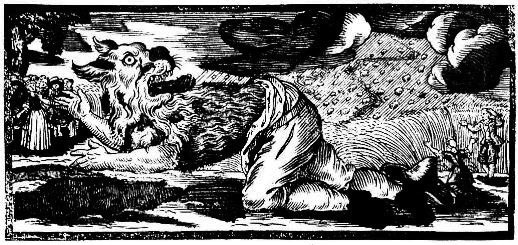This was an ask response on my Tumblr where I do most of my folklore blogging, but it was popular enough there that I figured I should post it here, too!
okeketochi1 asked:
Usually when referring to werewolves people tackle them in a pretty broad scope. Referring to Le Lobizon, the loup-garou, King lycaon, etc…but what is the mythology surrounding the werwulf or werewolf specifically? Like the German middle age definition of a werewolf?
That’s a very complicated question – but it’s also not. If that makes any sense at all. Let me elaborate…
What we call “werewolves” has almost become retroactive. We can’t really say that “werewolf” is a uniquely German term, despite being Germanic in nature, because our first recorded use of a variant of “werewolf” wasn’t even recorded in Germany. “Werewolf” never appeared very much in medieval writings, despite originating during the medieval period (more on that in a minute). Yes, you can find people using the term “werewolf” (and its assorted variations), but sadly, it often becomes a matter of asking: is this a real source, or is this something someone is falsifying?

This is a woodcut from 1722 in Germany of a werewolf. It’s one of the few instances we do have that is directly referred to as a “werewolf,” so we can be sure their werewolf legends in the 1700s, at least, weren’t too far off the mark from the kind of thing we have today.
You can find lots of “werewolf legends” in Germany from the 1800s and around that general time period that supposedly throw around the term “werewolf” (again, and its variations), but having read many of these myself and researched their sources and origins, I can tell you that the overwhelming majority of these things are just… nonsense. They weren’t legends. They were basically short stories, fake local tales, and generally untrue “folklore,” for whatever reason people had to be producing it. (What’s one way you can spot these? Several of them mention silver) There is a glut of utterly fake “German werewolf folklore” out there from the 1800s especially.
At any rate, as for the Middle Ages in Germany and what they considered to be werewolves, we have to look at Germanic folklore and mythology for that. In the pre-Middle Ages, early Middle Ages, and even into the mid Middle Ages, much of the Germanic regions of Europe were dominated by the old Germanic concepts – namely berserkers (which, again, were not bear warriors) and related legends.
It wasn’t really until after the Middle Ages that the word “werewolf” became used often across multiple regions. Much of what we call “werewolves” today is a retroactive label or translation.
What may have been the first use of the word “werewolf” appeared in the early 1000s. To quote my book, The Werewolf: Past and Future…
Much like what happened with the Vikings, as the medieval world converted to Christianity, werewolves were cast in a steadily more negative light. The king of England from 1016-1035, King Cnut, issued the Ecclesiastical Ordinances XXVI, in which he specifically mentions the werewolf in relation to the Devil, saying, “[be watchful, that] the madly audacious were-wolf do not too widely devastate, nor bite too many of the spiritual flock.”[1] This passage marks one of the earliest instances in which the term “werewolf” is virtually equated to the Devil or demons in general in Christianity, which becomes common in later medieval writings – and it also marks the first recorded use of the word “werewolf.” Instead of the wolf being a brother and wolf transformations being desirable, or at least not worthy of condemnation, Christianity altered the view of werewolves, turning them into demonic creatures associated with evil and witchcraft, who romp across the countryside leaving death and destruction in their wake. As stated by Beresford, “[T]he use of the werewolf as a religious scapegoat by the Church throughout the Middle Ages is intrinsic to the development of the myth of the modern beast. What was once … a highly revered and worshipped beast, emerges in the medieval period as a savage creature, poisonous, destructive and wholly evil; a beast to be feared and not imitated.”[2]
[1]Beresford 80, quoting Ecclesiastical Ordinances XXVI by King Cnut of England [2]Beresford 88. However, in this passage, he does not seem to wholly take into account just how many medieval werewolf legends existed, and how some of them were not necessarily demonic – these were, however, more often than not, unrelated to the Church (except for a few cases, which Beresford himself also cites in his book), so his point largely still stands.
Another direct use of the word “werewolf” appears in assorted medieval lays about werewolf knights, such as Marie de France’s Bisclavret, Sir Thomas Malory’s Le Morte d’Arthur, written in 1470, etc. So, in many ways, you could even say the proper medieval concept of a werewolf was a noble knight, as they were actually directly called “werewolves!”
It’s all but impossible, in folklore and myth, to nail down certain legends about certain creatures. This is because folklore and myth are very indirect, as compared to the kind of things people create today in pop culture. A true “werewolf legend” spans tons of legends – and simultaneously almost none at all. Scholars have often dictated what is and isn’t a werewolf legend, and their decisions about it frequently don’t even make any sense (especially if you ask me). This applies to so many creatures, including both werewolves and vampires, and that’s why when someone asks me “what were dragons like in folklore?” I can’t give a direct answer. I have to almost write a book on it, because all monsters and creatures in folklore have very complicated backgrounds, many different names, often didn’t go by the names we put on them today at all, etc.
I hope this helped! Sorry I couldn’t give a more direct answer. Some other useful werewolf facts for this topic: